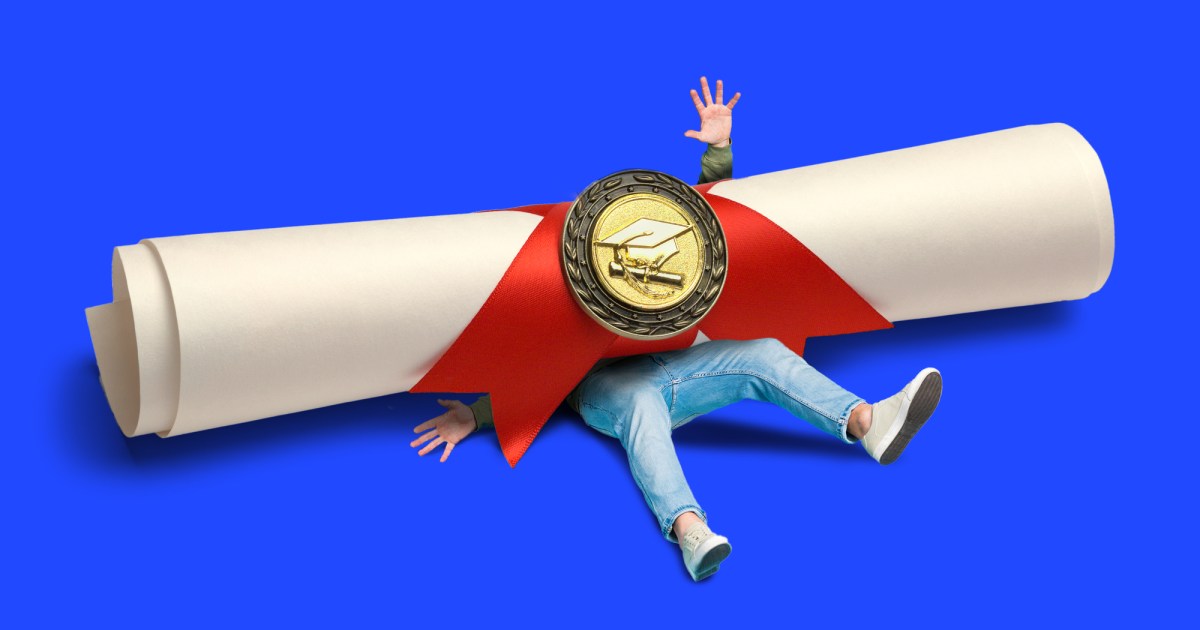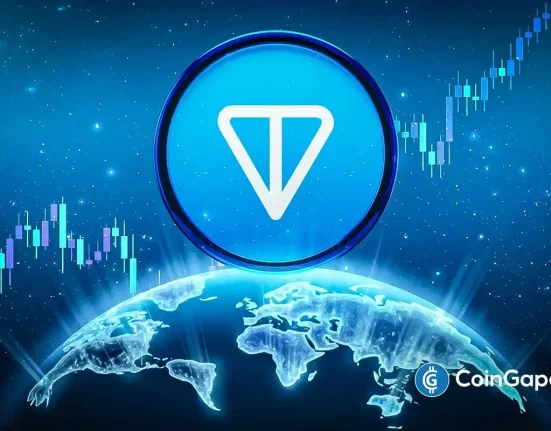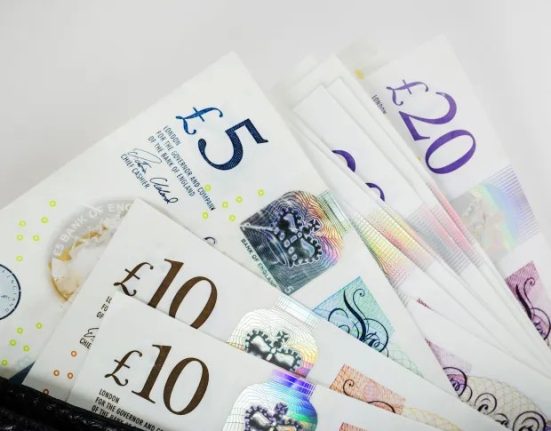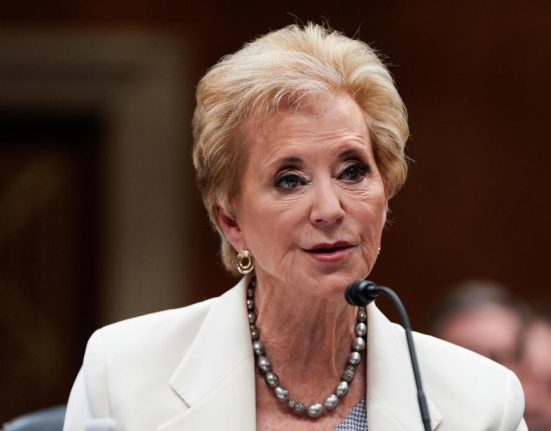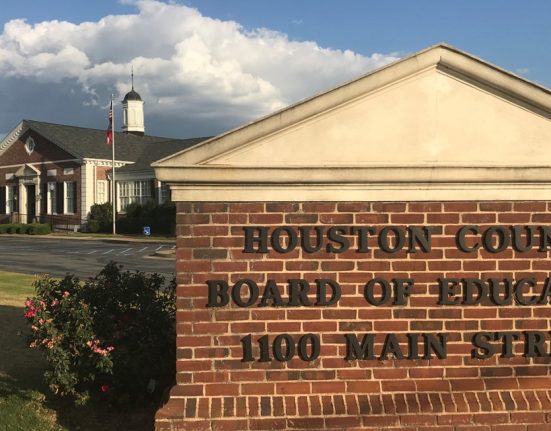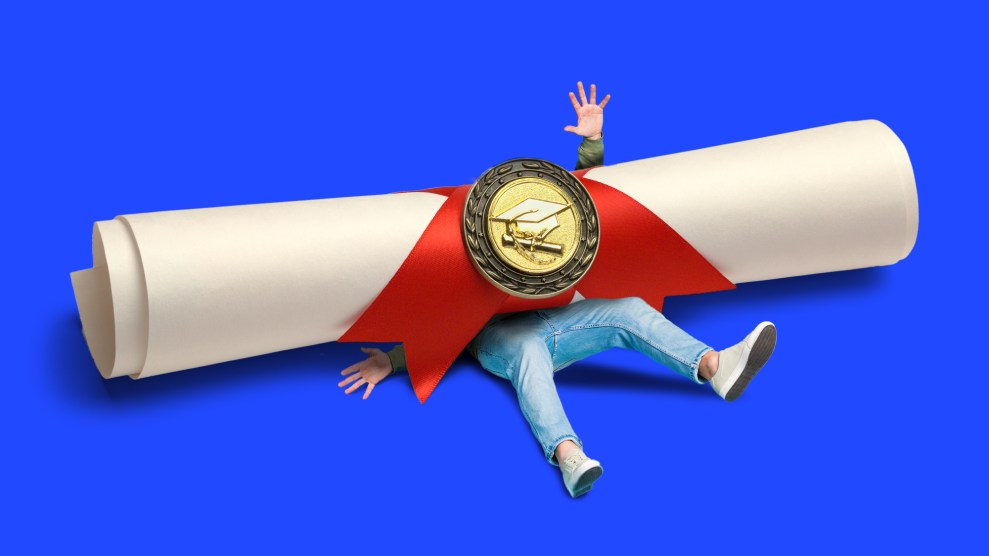
Mother Jones illustration; Getty
When President Joe Biden announced the creation of the Saving on a Valuable Education (SAVE) program in 2023, Sarah Letsinger enrolled immediately. Graduating in 2012 with a degree in fashion design, Letsinger never earned more than $16 an hour in her chosen field—and hardly made a dent in her approximately $35,000 in federal student loans. After she gave birth to her daughter in March 2020, the day her state of Illinois announced its Covid lockdown, she realized that if she returned to work, her wages would just go toward childcare. So she decided to focus on being a mom.
SAVE reduced borrowers’ loan payments to manageable levels and waived interest charges that exceeded their monthly payments—effectively lowering interest rates to 0 percent for the lowest-income borrowers. Under the program, Letsinger’s monthly payments fell to almost zero. “I was like, ‘Oh, my God, this is amazing,’” she says. She and her husband still had lots of student debt from his studies to become a nurse, and eventually a nurse practitioner: more than $65,000 in mostly-private loans that don’t qualify for any federal help. But SAVE meant “I could breathe a little,” Letsinger says. “I don’t have to panic about it.”
Now that sense of relief has evaporated. For the past year, while Republican-led challenges to the plan play out in court, no SAVE borrowers have been charged interest on their loans or been expected to make payments. But three weeks ago, the Trump administration suddenly announced it was ditching the SAVE plan’s litigation-induced 0 percent interest cap as of August 1; going forward, 7.7 million borrowers enrolled in the program will start accruing interest on their federal loans at rates that for some people could exceed 9 percent per year. That announcement followed the news that, under the GOP’s “Big, Beautiful Bill,” SAVE and other federal payment plans aimed at helping low- and moderate-income borrowers will end entirely by July 2028.
The programs have fallen victim to the same wrecking ball that President Donald Trump and Education Secretary Linda McMahon have used to go after the rest of the US education system—from issuing executive orders targeting trans students, to slashing federal funding for academic research, to drastically reducing the Department of Education workforce as the first step toward dismantling the entire agency. The rollout of the SAVE changes has been typically messy, creating new levels of confusion and anxiety among the millions of borrowers who find themselves suddenly facing significant hits to their finances, with little clarification from the federal government or loan servicers about what will happen next.
“It’s just isolating, being in debt that you didn’t realize you’d have when you were signing all those papers at 18 years old.”
With more than $100,000 in student debt hanging over their heads, the Letsingers have already made sacrifices: They can’t afford to move out of the house they bought in northern Illinois, even though neither of them imagined they’d settle there. They’re unable to travel to see Letsinger’s family in western New York. They’ve returned items to the store to pay off bills. They’ve given up hobbies—Letsinger loves to sew—that cost money to pursue but don’t generate income. And their hopes for future children seem far out of reach.
“I feel like we’re holding our breath while watching a train crash,” Letsinger tells me. “It’s just isolating, being in debt that you didn’t realize you’d have when you were signing all those papers at 18 years old.”
Biden unveiled the SAVE program days after the US Supreme Court ruled that the administration’s earlier initiative to cancel $400 billion in student debt for 40 million borrowers was unconstitutional. As they did with Biden’s earlier efforts, Republican state attorneys general filed suit against SAVE shortly before the program went into full effect. In July 2024, following preliminary injunctions on portions of the plan, the Biden administration placed SAVE enrollees into administrative forbearance, a kind of limbo that paused required payments, froze loan balances, and locked interest at 0 percent for all enrollees—where the program has remained even as the Trump administration set about dismantling it. The SAVE plan is “illegal,” Trump’s Education Department declared in a July 9 announcement, taking up a line of attack that Republicans have used in their legal challenges.
Even though the court cases are still pending, the administration is pressuring borrowers to switch now to a different federal repayment plan for low- and moderate-income borrowers, known as the Income-Based Repayment (IBR) plan. Unlike other federal repayment programs, IBR was created by Congress, which has insulated it from GOP legal challenges. It’s not yet clear how switching to IBR will impact individual borrowers, says Abby Shafroth, director of the National Consumer Law Center’s Student Loan Borrower Assistance Project. But if their applications for IBR are approved—which Shafroth is skeptical will occur quickly and/or accurately—borrowers should expect higher monthly payments and a longer path to forgiveness, she says.
The situation is even more confusing for the millions of borrowers, like school teacher Bryan Riha, who are also enrolled in the Public Service Loan Forgiveness (PSLF) program, another Trump target. Last October, Riha reached a key PSLF milestone: 120 months of public-sector employment. Under the program, enacted by Congress in 2007, that made him eligible to have his $90,000 in student debt wiped clean.
That same month, Riha also should have met the program’s other requirement for debt forgiveness: 120 monthly payments. But after SAVE enrollees were placed in administrative forbearance last summer, Riha was unable to make loan payments that would have counted toward forgiveness. Instead, his clock has been stuck at 116 out of 120 monthly payments. He requested to “buy back” his four remaining months of payments, meaning he’d pay up front what he would have owed during those months in forbearance. Theoretically, this should result in his remaining loans eventually being forgiven, but his request has remained open for more than eight months. “There’s really no end in sight,” Riha says.
“I could really see a future where forgiveness is just never part of the picture.”
With the Trump administration’s changes to the SAVE program, now interest will start accruing again, jacking up the total eventually due. Riha knows how quickly that can add up. When he earned his master’s degree in English in 2013, his student debt totaled about $70,000. Now, accrued interest has pushed his balance $20,000 higher. Forgiveness is a lifeline for Riha: “As a teacher, you don’t make nearly enough to cover [such enormous debt] over the course of a lifetime.”
Riha remains “cautiously optimistic” that his loans will eventually be forgiven. But he worries that the future for other borrowers looks bleak. Indeed, in March, Trump signed an executive order directing McMahon to revamp the PSLF program to exclude work for nonprofit and public sector employers whose activities purportedly have “a substantial illegal purpose.” Those supposedly “illegal” activities include supporting gender-affirming care and promoting diversity, equity, and inclusion. “I could really see a future where forgiveness is just never part of the picture,” Riha says.
Trump’s Department of Education justifies its decision to rescind the SAVE plan’s 0 percent interest cap by pointing to the federal lawsuits—namely, a nationwide preliminary injunction issued by a federal court in Missouri in April. The administration claimed its goal is to “bring fiscal responsibility to the federal student loan portfolio.”
But far from being mandated by the courts, the department’s move to resume interest charges was entirely elective, says Shafroth of the Student Loan Borrower Assistance Project. “These injunctions do not require the department to charge interest to borrowers during the SAVE forbearance,” she says. Another group, the Student Borrower Protection Center, estimates that the average SAVE enrollee will see an additional $3,500 in “unnecessary interest charges” each year, with the lowest-income borrowers being hit the hardest.
And in pushing SAVE enrollees toward the IBR plan, the administration is creating enormous new headaches for borrowers, Shafroth says. Indeed, in a case brought by labor unions challenging Trump’s student loan policies, the Department of Education admitted that as of June, there were already more than 1.5 million outstanding applications for enrollment in any type of income-driven repayment plan. Not only will the monthly obligations under IBR be more than double what some borrowers expected to pay with SAVE, borrowers eligible for loan forgiveness, like Riha, may not be any closer to having their debt wiped clean. The Education Department quietly announced in a Q-and-A in early July that it had paused forgiveness under IBR while “systems are updated.”
When the existing income-driven plans end in 2028, Shafroth says, they will be replaced by yet another program, this one called the “Repayment Assistance Plan,” which will result in higher monthly payments while locking borrowers into three decades of payments before they’re eligible for forgiveness.
“I always wanted to travel. I wanted to have a family. I wanted to have lots and lots of dogs. And that dream is looking more and more distant.”
“In many cases, they’re going to face higher monthly payments than they’ve had in the past, and [higher than] they might be able to afford,” Shafroth says. She says the lowest-income borrowers, including those who took out the smallest amounts or who never obtained degrees, are most at risk for defaulting on their student debt.
Like many of the 43 million Americans who have taken out federal student loans in hopes of creating a better future, Lauren Gardner, a Denver-based telehealth therapist who specializes in obsessive-compulsive disorder, is grieving as debt now threatens to crush her. “I always wanted to travel,” she says. “I wanted to have a family. I wanted to have lots and lots of dogs. And that dream is looking more and more distant as I continue to live in a one-bedroom apartment into my 40s.”
Gardner finished her undergraduate education shortly before the Great Recession. After years of working in jobs she wasn’t passionate about, she decided to return to school to become a licensed therapist, graduating in December 2019 with about $90,000 in federal loans.
“I knew it was going to be hard, and I knew I was going to probably have this debt forever,” Gardner says. But her choices, she says, were either to continue struggling to make ends meet or “take the risk and know what I’m getting into, and hold on to this hope that it works out better than I think it’s going to.”
In one way, Gardner was lucky. In March 2020—a few months before her payments were expected to begin—the pandemic led the federal government to pause all student loan payments, locking them at a 0 percent interest rate. By time the Covid emergency ended in September 2023, Gardner had enrolled in SAVE. She made her first loan payment that October, she tells me, reading off the ledger from her loan servicer. It was $19.37.
But now, with interest, Gardner’s debt has climbed to more than $100,000—and the SAVE lifeline is going away. She’s not sure what her interest charges will be in the future—she’s repeatedly had problems logging into her loan servicer’s portal, a problem Shafroth has been hearing about from other borrowers as well—but she worries her interest could accrue at the rate of at least $1,000 per month.
Many therapists, including Gardner, make intern-level wages at the start of their careers; only a few months ago did she begin earning an income that was “survivable in the current economy,” she says. Gardner also has chronic health issues that are costly to manage. The extra $1,000 a month “would wipe out my savings in about two months,” she says. In the long term, “I have no idea what would happen or if I would be able to survive it.”

